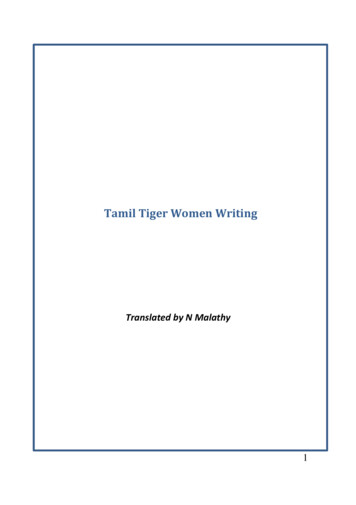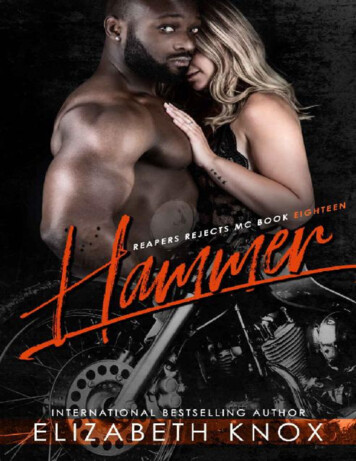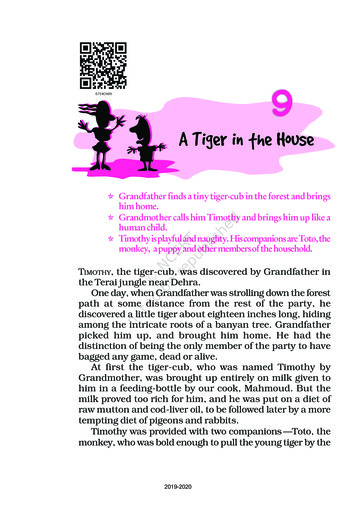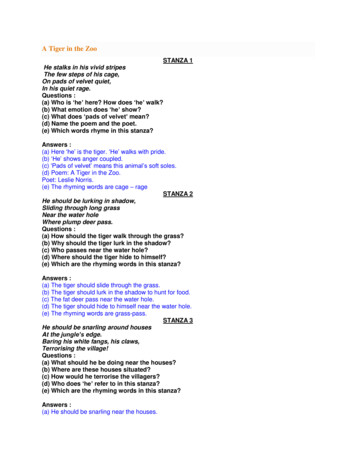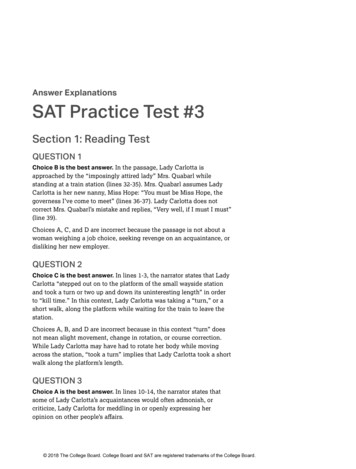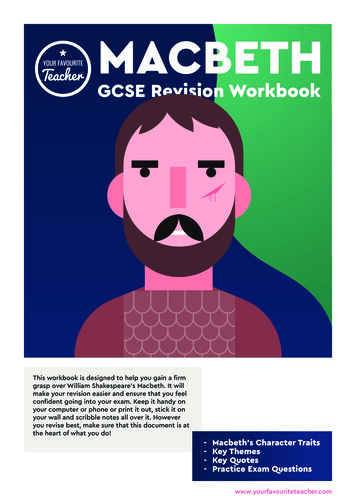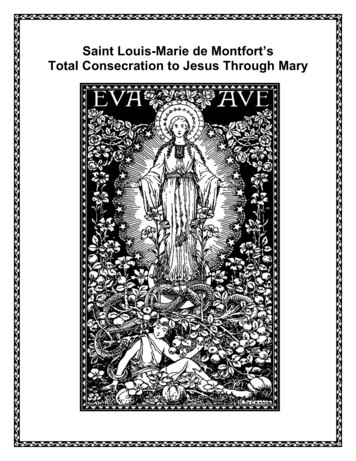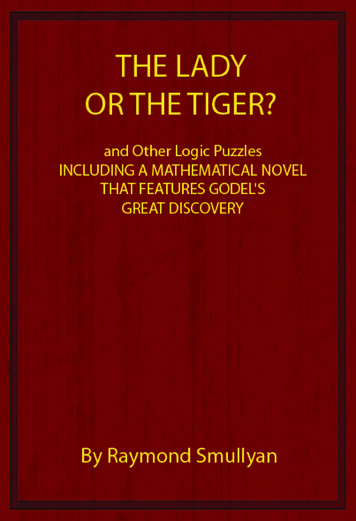
Transcription
ALSO BY RAYMOND SMULLYANTheory of Formal SystemsFirst Order LogicThe Tao Is SilentWhat Is the Name of This Book?This Book Needs No TitleThe Chess Mysteries of Sherlock HolmesThe Chess Mysteries of the Arabian KnightsThe Devil, Cantor and Infinity
THE LADYOR THE TIGER?
THE LADYOR THE TIGER?and Other Logic PuzzlesINCLUDING A MATHEMATICAL NOVELTHAT FEATURES GODEL'SGREATDISCOVERYBYRaymond Smullyan
Copyright 1982 by Raymond SmullyanAll rights reserved under International and Pan-American CopyrightConventions. Published in the United Statesby Times Books, a division of Random House, Inc., New York,and simultaneously in Canada by Random House of Canada Limited,Toronto. This work was originally published in hardcoverby Alfred A. Knopf, Inc., New York in 1982.The problems in Chapter 3, "The Asylum of Doctor Tarrand Professor Fether," originally appearedinThe Two-Year College Mathematics Journal.Library of Congress Cataloging-in-Publication DataSmullyan, Raymond M.The lady or the tiger? : and other logic puzzles, including amathematical novel that features Coders great discovery / byRaymond Smullyan. - 1st ed.p.cm.Originally published: New York : Knopf, 1982.ISBN 0-8129-2117-8 (pbk.)1. Puzzles.2. Mathematical recreationsrecreations.3. PhilosophicalI. Title.[CV1493·S6261992]793· 73-dc20Manufactured in the United States of America98765432First Times Books Paperback Edition
ContentsPrefacevii1PART I . T HE LADY OR T HE T IGER?1Chestnuts-Old and New23Ladies or Tigers?314The Asylum of Doctor Tau and Professor Fether4Inspector Craig Visits Transylvania45PART II. P U Z Z LE S AND MET AP U·Z Z LES 6 15The Island of Questioners6The Isle of Dreams7Metapuzzles637991PART III T HE MYST ERY OF T HEMONT E CARI.;O LOCK. 1018The Mystery of the Monte Carlo Lock9A Curious Number Machine10Craig's Lawv12410910329
C O N TE N TS1112Fergusson's Laws143Interlude: Let's Generalize!13The Key155159PART IV SOLVABLE OR UNSOLVABLE? 16714Fergusson's Logic Machine1516Provability and Truth16g180193Machines That Talk About Themselves1718Mortal and Immortal Numbers207The Machine That Never Got Built19Leibniiz's Dreamvi219214
Pref aceAmong the numerous fascinating letters I have received con cerning my first puzzle book (whose name I can never re member!), one was from the ten-year-old son of a famousmathematician who was a former classmate of mine. The let ter contained a beautiful original puzzle, inspired by some ofthe puzzles in my book which the boy had been avidly read ing. I promptly phoned the father to congratulate him on hisson's cleverness. Before he called the boy to the phone, thefather said to me in soft conspiratorial tones: "He is readingyour book and loves it! But when you speak to him, don't lethim know that what he is doing is math, because hehatesmath! If he had any idea that this is really math, he wouldstop reading the book immediately!"I mention this because it illustrates a most curious, yetcommon, phenomenon: So many people I have met claim tohate math, and yet are enormously intrigued by any logic ormath problem I give them, provided I present it in the formof a puzzle. I would not be at all surprised if good puzzlebooks prove to be one of the best cures for so-called "mathanxiety." Moreover, any math treatisecould be written in theformat of a puzzle book! I have sometimes wondered whatwould have happened if Euclid had written his classic Ele-vii
P R E FA C Ementsin such a format. For example, instead of stating as atheorem that the base angles of an isosceles triangle areequal, and then giving the proof, he could have written:"Problem:Given a triangle with two equal sides, are two ofthe angles necessarily equal? Why, or why not? (For the solu tion, see page -.)" And similarly with all the rest of his theo rems. Such a book might well have become one of the mostpopular puzzle books in historylIn general, my own puzzle books tend to be different fromothers in that I am primarily concerned with puzzles thatbear a significant relation to deep and important results inlogic and mathematics. Thus, the real aim of my first logicbook was to give the general public an inkling of whatGodeI's great theorem was about. The volume you are nowholding goes still further in this direction. I used the manu script of it in a course entitled "Puzzles and Paradoxes,"where one of the students remarked to me: "You know, thiswhole book-particularly parts Three and Four-has muchthe flavor of a mathematical novel. I have never before seenanything like it!"I think the phrase "mathematical novel" is particularlyapt. Most of this book is indeed in the form of a narrative, anda good alternative title for it would be "The Mystery of theMonte Carlo Lock," since the last half concerns a case inwhich Inspector Craig of Scotland Yard must discover a com bination that will open the lock of a safe in Monte Carlo toprevent a disaster. When his initial efforts to crack the caseprove unsuccessful, the inspector returns to London, wherehe serendipitously renews acquaintance with a brilliant andeccentric inventor of number machines. Together they teamup with a mathematical logician, and soon the three findthemselves in ever-deepening waters that flow into the veryheart of Godel's great discovery. The Monte Carlo lock, ofcourse, turns out to be a "Godelian" lock in disguise, itsviii
P R E FA C Emodus operandiCodel'sbeautifully reflecting a fundamental idea ofthat has basic ramifications in many scientifictheories dealing with the remarkable phenomenon of self-re production.As a noteworthy dividend, the investigations of Craig andhis friends lead to some startling mathematical discoverieshitherto unknown to either the general public or the scien tific community. These are "Craig's laws" and "Fergusson'slaws," which are published here for the very first time. Theyshould prove of equal interest to the layman, the logician, thelinguist, and the computer scientist.This whole book has been great fun to write, and should beequal fun to read. I am planning several sequels. Again I wishto thank my editor, Ann Close, and the production editor,Melvin Rosenthal, for the wonderful help they have givenme.RAYM OND S MULLYANElka Park, N. Y.February 1982ix
P A R TO N ETHELADYOR THETIGER?
IIIIIII'I'I'I'I,I, I, I, I, I, I, IIIIIIIIIIIIIIIIIIIIIIIIIIIIIIII
Chestnuts Old and NewI would like to begin with a series of miscellaneous arithmeti cal and logical puzzles--some new, some old.1 How Mu ch ?Suppose you and I have the same amount of money. Howmuch must I give you so that you have ten dollars morethan I? (Solutions come at the end of each chapter.)2 The Po lit ician Puzz leA certain convention numbered one hundred politicians.Each politician was either crooked or honest. We are giventhe following two facts:(1)(2)At least one of the politicians was honest.Given any two of the politicians, at least one of the twowas crooked.Can it be determined from these two facts how many ofthe politicians were honest and how many were crooked?3
T H E L A D Y O R T H E T I G E R?3 Old Wine inaNot-so-new BottleA bottle of wine cost ten dollars. The wine was worth ninedollars more than the bottle. How much was the bottleworth?4 How Much Profit?The amazing thing about this puzzle is that people alwaysseem to fight over the answer! Yes, different people work itout in different ways and come up with different answers,and each insists his answer is correct. The puzzle is this: 7, sold it for 8, bought itback for 9, and sold it for 10. How much profit did heA dealer bought an article formake?5 Problem of the Ten PetsThe instructive thing about this puzzle is that although it caneasily be solved by using elementary algebra, it can also besolved without any algebra at all-just by plain commonsense. Moreover, the common-sense solution is, in my judg ment, far more interesting and informative-and certainlymore creative-than the algebraic solution.Fifty-six biscuits are to be fed to ten pets; each pet is eithera cat or a dog. Each dog is to get six biscuits, and each cat isto get five. How many dogs and how many cats are there?Any reader familiar with algebra can get this immediately.Also, the problem can be solved routinely by trial and error:there are eleven possibilities for the number of cats (any where from zero to ten), so each possibility can be tried untilthe correct answer is found. But if you look at this problem in4
CHESTNUTS-O L D A N D N EWjust the right light, there is a surprisingly simple solution thatinvolves neither algebra nor trial-an d-e rror. So, I urge eventhose of you who have gotten the answer by your ownmetho d to consult the solution I give.6 Lar ge Bir ds and Small BirdsHere is another puzzle that can be solv ed either by algebra orby common sense, an d again I prefer the common-sensesol ution.A certain pet shop sells large bir ds an d small bir ds; eachlarge bir d fetches twice the price of a small one. A la dy camein an d purchase d five large bir ds an d three small ones. If, in stea d, she ha d bought three large bir ds an d five small bir ds,she woul d have spent 20 less. What is the pri ce of each bir d?7 The Disad van ta ges o f Bein gAbsen t-mindedThe following story happens to be true:It is well known that in any group of at least 23 people, theo dds are greater than 50 percent that at least two of themwill have the same birth day. Now, I was once teaching an un dergra duate mathematics class at Princeton, an d we weredoing a little elementary probability theory . I explaine d tothe class that with 30 people instea d of 23, the o dds woul dbecome enormously high that at least two of them ha d thesame birth day."Now," I continue d, "since there are only nineteen stu dents in this class, the o dds are much less than fifty percentthat any two of you have the same birth day."At this point one of the stu dents raise d his han d an d sai d,5
T H E L A D Y O R T H E T I G E R?''I'll bet you that at least two of us here have the same birth day.""It wouldn 't be right for me to take the bet," I replied,"because the probabilities would be highly in my favor.""I don 't care," said the student, ''I 'll bet you anyhow! ""All right," I said, thinking to teach the student a good les son. I then proceeded to call on the students one by one toannounce their birthdays until, about hal fway through, bothI and the class burst out laughing at my stupidity.The boy who had so confidently made the bet did not knowthe birthday of anyone present except his own. Can you guesswhy he was so confident?8 Repu bli cans and Demo cra tsIn a certain lodge, each member was either a Republican or aDemocrat. One day one of the Democrats decided to becomea Republican, and after this happened, there was the samenumber of Republicans as Democrats. A few weeks later, thenew Republican decided to become a Democrat again, and sothings were back to normal. Then another Republican de cided to become a Democrat, at which point there weretwice as many Democrats as Republicans.Ho w many members did the lodge contain?9 A New "Co lored Ha ts " Pro blemThree subjects-A, B, and C-were all perfect logicians.Each could instantly deduce all consequences of any set ofpremises. Also, each was aware that each of the others was aperfect logician. The three were shown seven stamps: two6I
CHESTNUTS-O L D A N D N EWred ones, two yellow ones, and three green ones. They werethen blindfolded, and a stamp was pasted on each of theirforeheads; the remaining four stamps were placed . in adrawer. When the blindfolds were removed, A was asked,"Do you know one color that you definitely do not have?" Areplied, "No." Then B was asked the same question and re plied, "No."Is it possible, from this information, to deduce the color ofA's stamp, or of B's, or of C's?10 For Those Who Know theRules o f ChessI would like to call your attention to a fascinating variety ofchess problem which, unlike the conventional chess prob lem-White to play and mate in so-many moves-involvesan analysis of the past history of the game: how the positionarose.Inspector Craig of Scotland Yard, whose interest in thistype of problem was equal to that of Sherlock Holmes, t oncewalked with a friend into a chess club, where they cameacrossanabandoned chessboard."Whoever played this game," said the friend, "certainlydoesn't know the rules of chess. The position is quite impos sible!""Why?" asked Craig."Because," replied the friend, "Black is now in check fromboth the White rook and the White bishop. How couldWhite possibly have administered this check? If he has just Inspector Craig is a character from my previous book of logic puzzles,What Is the Name of This Book?t My book The Chess Mysteries of Sherlock Holmesthis genre.7contains many puzzles of
THE L A D Y OR THE T I G E R?moved the rook, the Black king would already be in checkfrom the bishop, and if he has just moved the bishop, the kingwould already be in check from the rook. So, you see, the po sition is impossible."Craig studied the position for a while. "Not so," he said,"the position, though exceedingly bizarre, is well within thebounds of legal possibilities."Craig was absolutely right! Despite all appearances to thecontrary, the position really is possible, and it can be deducedwhat "White's last move was. "What was it?SO L U T IONS .A common wrong answer is 10. Now, suppose we eachhad, say, 50. If I gave you 10, you would then have 60 and·I would have only 40; hence you would have 20 more thanI, rather than 10.The correct answer is 5.1 A fairly common answer is "50 honest and 50 crooked."Another rather frequent one is "51 honest and 49 crooked."2 8
CHESTNUTS-OLD AND NEWBoth answers are wrong! Now letussee how to find the cor rect solution.We are given that at least one person is honest. Let us pickout any one honest person, whose name, say, is Frank. Nowpick any of the remaining 99; call him John. By the secondgiven condition, at least one of the two men-Frank, JoOO is crooked. Since Frank is not crooked, it must be John. SinceJohn arbitrarily represents any of the remaining 99 men, theneach of those 99 men must be crooked. So the answer is thatone is honest and 99 are crooked.Another way of proving it is this: The statement that givenany two, at least one is crooked, says nothing more nor lessthan that given any two, they are not both honest; in otherwords, no two are honest. This means that at most one ishonest. Also (by the first condition), at least one is honest.Hence exactly one is honest.Do you prefer one proof to the other?3 A common wrong answer is 1. Now, if the bottle werereally worth a dollar, then the wine, being worth 9 morethan the bottle, would be worth 10. Hence the wine andbottle together would be worth 11. The correct answer isthat the bottle is worth 50 and the wine is worth 9.50.Then the two add up to 10.4 Some argue as follows: After having bought the articlefor 7 and sold it for 8, he has made a dollar profit. Then, bybuying the article back for 9 after having sold it for 8, heloses a dollar; hence at this point he is even. But then (the ar gument continues) by selling for 10 what he has bought for 9, he has made a dollar again; therefore, his total profit is 1.Another argument leads to the conclusion that the dealerbroke even: When he sold the article for 8 after having9
T H E L A D Y O R T H E T I G E R?bought it for 7, he made 1 profit. But then he loses 2 bybuying back for 9 the item for which he originally pai d 7,an d so at this point he is 1 in the hole. Then he g ets back thedollar by selling for 10 the article for which he last paid 9,and so now he is even.Both arguments are wrong; the correct answer is that thedealer ma de 2. There are several ways to arrive at this--on esuch goes as follows: First, after selling for 8 the article forwhich he has paid 7, he has clearly made 1 . Now, supposethat instead of buying back the same article for 9 and ,thenselling it for 10, he were to buy a different article for 9 andsell it for 10. Woul d this really be any different from apurely economic point of view? Of course not! He would ob viously, then, be making another dollar on the buying andselling of this second article. Thus, he has made 2.Another and ve ry simple proof: The de aler's total outlay is 7 9 16, an d his total return is 8 10 18, givinga profit of 2.For those not convinced by these arguments, let us supposethat the dealer has a certain amount of money -say, 10 0- at the opening o f the day and that he makes just these fourdeals. How much will he have at the close of the day? Well,first he pays 7 for the article, leaving him with 93. Then hesells the article for 8, giving him 10 1 . Next he buys the ar ticle back for 9, bringing him down to 92. Finally, he sellsthe article for 10 and thus winds up with 102. So he hasstarte d the day with 100 an d en de d it with 102. How, then,coul d his profit be anything other than 2?5 The solution I have in mind is this: First feed five biscuitsto each of the ten pets; this leaves six biscuits. Now, the catshave alrea dy ha d their portion! Therefore, the six remain ing biscuits are for the dogs, and since each dog is to get10
C H E S T N U T S- O L D A N D N E Wone more biscuit, there must be six dogs, and thus four cats.Of course, we can check out the solution: Six dogs eachgetting six biscuits accounts for thirty-six biscuits. Four catseach getting five biscuits accounts for twenty biscuits. Thetotal (36 20) is 56, as it should be. Since each large bird is worth two small birds, then fivelarge birds are worth ten small birds. Hence five large birdsplus three small birds are worth thirteen small birds. On theother hand, three large birds plus five small birds are wortheleven small birds. So the difference between buying fivelarge and three small birds or buying three large and fivesman birds is the same as the difference between buying thir teen small birds and buying eleven small birds, which is twosmall birds. We know that the difference is 20. So two smallbirds are worth 20, which means one small bird is worth 10.Let us check: A small bird is worth 10, and a large bird 2 0. Therefore, the lady's bill for five large and three smallbirds was 130. Had she bought three large and five smallbirds, she would have spent 1 10, which is indeed 20 less.67 At the time I accepted the bet from the student, I hadtotally forgotten that two of the other students, who alwayssat next to each other, were identical twins.8 There were twelve members: seven Democrats and fiveRepublicans.9 The only one whose color can be determined is C. If C'sstamp were red, then B would have known that his stampwas not red by reasoning: "If my stamp were also red, then A,seeing two red stamps, would know that his stamp is not red.11
THE L A D Y OR THE T I G E R?But A does not know that his stamp is not red. Therefore, mystamp cannot be red."This proves that if C's stamp were red, then B would haveknown that his stamp was not red. But B did not know thathis stamp was not red; therefore, C's stamp cannot be red.The same argument, replacing the word red with yellow,shows that C's stamp cannot be yellow either. Therefore, C'sstamp must be green.10 It is not given which side of the board is White andwhich side is Black. It may well appear that White is movingup the board, but if he really were, then the position wouldbe impossible! The truth is that White must be moving downthe board, and that before the last move, the position wasthis:The circle on the lower left-hand square represents someBlack piece (either a queen, rook, bishop, or knight; there isno way to know which). The White pawn then captures thisBlack piece and promotes to a rook, bringing the game to thepresent position.12
C H EST N U TS-OLD AND NEWOf course, one might wen ask: "Why did White promoteto a rook instead o f a queen; is this not highly improbable?"The answer is that indeed it is highly improbable, but thatany other last move is not merely improbable but impossible,and as Sherlock Holmes so wisely said to Watson: "When wehave eliminated the impossible, whatever remains, howeverimprobable, must be the truth. "
Ladies orTigers?Many of you are familiar with Frank Stockton's story "TheLady or the Tiger?," in which the prisoner must choose be tween two rooms, one of which contains a lady and the othera tiger. If he chooses the former, he marries the lady; if hechooses the latter, he (probably) gets eaten by the tiger.The king of a certain land had also read the story, and itgave him an idea. "Just the perfect way to try my prisoners! "he said one day to his minister. "Only, I won't leave i t tochance ; I'll have signs on the doors of the rooms, and in eachcase I'll tell the prisoner c ertain facts about the signs. If theprisoner is clever and can reason logically, he'll save hislife-and win a nice bride to boot ! ""Excellent idea! " said the minister.T H E T R IA L S O F T H E F IR S T D A YOn the first day, there were three trials. In all three, the kingexplained to the prisoner that each of the two rooms con tained either a lady or a tiger, but it could be that there were14
LADIES OR TIGERS?tigers in both rooms, or ladies in both rooms, or then again,maybe one room containe d a la dy an d the o ther room a tiger.1 The First Trial"Suppose both rooms contain tigers," aske d the prisoner.' What do I do then?""That's your hard luck! " replied the king."Suppose both rooms contain ladies?" asked the prisoner."Then, obviously, that's your good luck," replied the king."Surely you coul d have guesse d the answer to that! ""Well, suppose one room contains a lady an d the other atiger, what happens then?" asked the prisoner."In that case, it makes quite a difference which room youchoose, doesn't it?""How do I know which room to choose P" aske d the pris oner.The king pointed to the signs on the doors of the rooms:IIIIN THIS ROOM THEREIS A LADY, AND INTHE OTHER ROOMIN ONE OF THESE ROOMSTHERE IS A LADY, ANDIN ONE OF THESE ROOMSTHERE IS A TIGERTHERE IS A TIGER"Is i t true, what the signs say?" asked the prisoner."One of them is true," replied the king, "but the other oneis false."If you were the prisoner, which door woul d you open (as su ming, of course, that you preferred the lady to the tiger)?
THE LADY OR THE TIGER?.2 The Se oond TrialAnd so, the first prisoner saved his life and made off with thelady. The signs on the doors were then changed, and new oc cupants for the rooms were selected accordingly. This timethe signs read as follows:IIIAT LEAST ONE OF THESEA TIGER IS INROOMS CONTAINS A LADYTHE OTHER ROOM"Are the statements on the signs true?" asked the secondprisoner."They are either both true or both false," replied the king.Which room should the prisoner pick?3 The Thir d TrialIn this trial, the king explained that, again, the signs wereeither both true or both false. Here are the signs:IEITHER A TIGER IS INTHIS ROOM OR A LADY ISIN THE OTHER ROOMIIA LA DY IS INTHE O THER ROO MDoes the first room contain a lady or a tiger? What aboutthe other room?
L A D IE SORTI G E R S?T H E SE C ON D D A Y"Yesterday was a fiasco," said the king to his minister. "Allthree prisoners solved their puzzles! Well, we have five trialscoming up today, and I think I'n make them a little tougher.""Excellent idea!" said the minister.Well, in each of the trials of this day, the king explainedthat in the lefthand room (Room I), if a lady is in it, then thesign on the door is true, but if a tiger is in it, the sign is false.In the righthand room (Room II), the situation is the oppo site : a lady in the room means the sign on the door is false,and a tiger in the room means the sign is true. Again, it ispossible that both rooms contain ladies or both rooms containtigers, or that one room contains a lady and the other a tiger.4 The Fourth T rialAfter the king explained the above rules to the prisoner, hepOinted to the two signs:IIIBO T H ROOM SBOT H ROOM SCONTAIN LADIESCONTAIN LADIESWhich room should the prisoner pick?17
T H EL A DYORT H ETI G E R?5 The Fifth T rialThe same rules apply, and here are the signs:IIIAT LE AST ONE ROOMT H E OT H ER ROOMCONTAINS A LADYCONTAINS A LADY6 The S ixth T rialThe king was particularly fond of this puzzle, and the nextone too. Here are the signs:IIIIT MAKES NO DIFFERENCETHERE IS A LADYWHICH ROOM YOU PICKIN T H E OT HER ROOMWhat should the prisoner do?7 The Seven th T rialHere are the signs:IIIITDOES M A KE AYOU ARE BE TTERDIFFERE NCE W H IC HOFF C H OOS ING T H EROOM YOU PIC KOT HER ROOM"What should the prisoner do?
LAD I E S8 ORTI G E R S?The Eighth Trial"There are no signs above the doors! " exclaimed the prisoner."Quite true," said the king. "The signs were just made, andI haven't had time to put them up yet.""Then how do you expect me to choose?" demanded theprisoner."Well, here are the signs," replied the king.T H IS ROOMCONTAINSA TIGERBOT H ROOM SCONTAINTIGERS"That's all wen and good," said the prisoner anxiously,"but which sign goes on which door?"The king thought awhile. "I needn't ten you," he said."You can solve this problem without t hat information."Only remember, of course," he added, "that a lady in thelefthand room means the sign which should be on that door istrue and a tiger in it means the sign should be false, and thatthe reverse is true for the righthand room."What is the solution?T H E T H I R D DA Y"Confound it! " said the king. "Again all the prisoners won! Ithink tomorrow I'll have three rooms instead of two; I'll put a19
THE L A D Y OR THE T I G E R?lady in one room and a tiger in each of the other two rooms.Then we'll see how the prisoners fare! ""Excellent ideal" replied the minister."Your conversation, though flattering, is just a hit on therepetitious side! " exclaimed the king."Excellently putl " replied the minister.9 The Ninth TrialWell, on the third day, the king did as planned. He offeredthree rooms to choose from, and he explained to the prisonerthat one room contained a lady and the other two containedtigers. Here are the three signs:IIIIIIA TIGERA LADYA TIGERIS INIS INIS INTHIS ROOMTHIS ROOMROOM IIThe king explained that at most one of the three signs wastrue. Which room contains the lady?10 The Tenth TrialAgain there was only one lady and two tigers. The king ex plained to the prisoner that the sign on the door of the roomcontaining the lady was true, and that at least one of theother two signs was false.Here are the signs:20
LADIES OR TIGERS?IIIHIA TIGER ISIN RO OMUA TIGER ISIN THIS ROOMA TIGER ISIN ROOM IWhat should the prisoner do?1 1 F ir st, Se cond, and T hird C ho iceInthis more whimsical trial, the king explained to the pris oner that one of the three rooms contained a lady, another atiger, and the third room was empty. The sign on the door ofthe room containing the lady was true, the sign on the door ofthe room with the tiger was false, and the sign on the door ofthe empty room could be either true or false. Here are thesigns:IIIROOM IIIEMPTYTHE TIGER ISTHISIN ROOM IISISIIIRO OMEMPTYNow, the prisoner happened to know the lady in questionand wished to marry her. Therefore, although the emptyroom was preferable to the one with the tiger, his first choicewas the room with the lady.Which room contains the lady, and which room containsthe tiger? If you can answer these two questions, you shouldhave little difficulty in also determining which room isempty.21
THE LADY OR THE TIGER?T H E F OURT H D A Y"Horrible! " said the king. "It seems I can't make my puzzleshard enough to trap these fellows! Well, we have only onemore trial to go, but this time I'll really give the prisoner arun for his money!"12 A Logical Labyrin thWell, the king was as good as his word. Instead of havingthree rooms for the prisoner to choose from, he gave himnine! As he explained, only one room contained a lady; eachof the other eight either contained a tiger or was empty. And,the king added, the sign on the door of the room containingthe lady is true; the signs on doors of all rooms containingtigers are false; and the signs on doors of empty rooms can beeither true or false.Here are the signs:IIIIIIT HE LADYIS IN ANODD-N UMBEREDR OOMTHIS ROOMIS EMPTYEITHER SIGN VIS RIGHTOR S IGN VIIISWR ONGIVVVIS IG N IISWRONGEITHE RSIGN IIOR SIGN IVIS RIGH TSIGN IIIISWR ONG22
L A DIESORTIGER S?VIIIIXT H IS ROOMT H IS ROOMCONTAINSCONTAINSIS NOT INA TIGERA TIGERROOM!AND ROOM IXAND VIIS E MPTYIS WRONGVIITHE LADYThe prisoner studied the situation for a long while."The problem is unsolvable! " he exclaimed angrily."That's not fair! ""I know," laughed the king."Very funny!" replied the prisoner. "Come on, now, atleast give me a decent clue: is Room Eight empty or not?"The king was decent enough to tell him whether RoomVIn was empty or not, and the prisoner was then able to de duce where the lady was.Which room contained the lady? SOLUTIONS .1 We are given that one of the two signs is true and theother false. Could it be that the first is true and the secondfalse? Certainly not, because if the first sign is true, then thesecond sign must also be true-that is, if there is a lady inRoom I and a tiger in Room .H, then it is certainly the casethat one of the rooms contains a lady and the other a tiger.Since it is not the case that the first sign is true and the sec ond one false, then it must be that the second sign is true andthe first one false . Since the second sign is true, then therereally is a lady in one room and a tiger in the other. Since the23
THEL A DYOR THE TIGER?first sign is false, then it must be that the tiger is in Room Iand the lady in Room n. So the prisoner should choose Roomn.2 If Sign II is false, then Room I contains a lady; hence atleast one room contains a lady, which makes Sign I true.Therefore, it is impossible t
logic and mathematics. Thus, the real aim of my first logic book was to give the general public an inkling of what GodeI's great theorem was about. The volume you are now holding goes still further in this direction. I used the manu script of it in a course entitled "Puzzles and Paradoxes,


